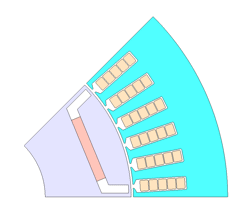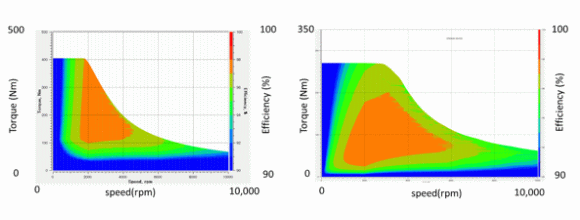Contents
1. Model-Based Development and efficiency maps
2. Motor efficiency map evaluation in the conceptual design stage
3. Efficiency Map Evaluation for Detailed Performance Evaluation
4. Summary
5. Reference
1. Model-Based Development and efficiency maps
In MBD, it is necessary to evaluate devices characteristics without having to wait for the manufacturing of a prototype. The motor efficiency map is one of the important evaluation items in motor drive system development. Therefore, it is necessary to be able to obtain the motor efficiency map with high accuracy using FEA simulation.
However, if we talk about an efficiency map evaluation, depending on the development stage the accuracy and calculation costs of the efficiency map are evaluated differently. Here, we consider the efficiency map evaluation in the following two stages:
- Conceptual design
- Detailed performance evaluation
In the conceptual design the characteristics of the machine are evaluated while changing its topology and shape. Therefore, it is necessary to evaluate the efficiency map for each generated shape. In order to evaluate a large number of cases, the cost (calculation time) spent on one map generation has to be limited. On the other hand, in the stage of detailed performance evaluation, a prototype is usually made, and the performance evaluation on a motor bench is performed. In MBD, bench tests are replaced with simulated virtual tests. Therefore, in simulation, an accuracy equivalent to a real machine is required.
Evaluation of efficiency map by simulation is possible by using FEA software. However, there are few documents that mention the map evaluation for each development stage as described above. This white paper explains the concept design and the efficiency map generation evaluation method in the detailed performance evaluation. Furthermore, the accuracy required for the map and the calculation cost, of its generation will be described.
2. Motor efficiency map evaluation in the conceptual design stage
The Efficiency map generation in the conceptual design uses maps of the different motor characteristics. A map of torque, flux linkage, and loss is generated with the current amplitude, phase, and rotational speed as parameters for a motor shape. Thereafter, according to the selected control method, the efficiency calculation is performed at the speed-torque curve and each operating point. The motor characteristic map has the following features.
- Torque, flux linkage, loss current amplitude, phase, and speed dependency (speed dependency is for iron loss only)
- Eddy current are not considered.
- Sine wave current waveform input (loss includes slot harmonics component)
The required resolution for the parameter of the efficiency map is going to be studied. For this purpose, the accuracy of the efficiency map was determined by the following method.
- Evaluate the efficiency of each point by dividing the speed map and the torque axis into 10 grids
- If the maximum error in efficiency (difference in efficiency values) compared to the map with the fine parameter resolution is 0.4% or less, it is considered that there is no difference (the same criteria will be used in the detailed performance efficiency map described later)
First we discuss the influence of the current amplitude resolution on the efficiency map. The current amplitude needs to have a resolution capable of capturing the maximum torque of the NT curve, and taking into account the effect of magnetic saturation. Fig. 2 shows the efficiency map when the current amplitude resolution is changed. The maximum error was less than 0.4% in all maps, and we found that an efficiency map could be evaluated with 4 points of amplitude. The torque and linkage flux map for each case is shown in Fig. 3.

Analysis target (permanent magnet synchronous motor)

Simplified efficiency map and motor using characteristics
You need to sign in as a Regular JMAG Software User (paid user) or JMAG WEB MEMBER (free membership).
By registering as a JMAG WEB MEMBER, you can browse technical materials and other member-only contents for free.
If you are not registered, click the “Create an Account” button.
Create an Account Sign in



